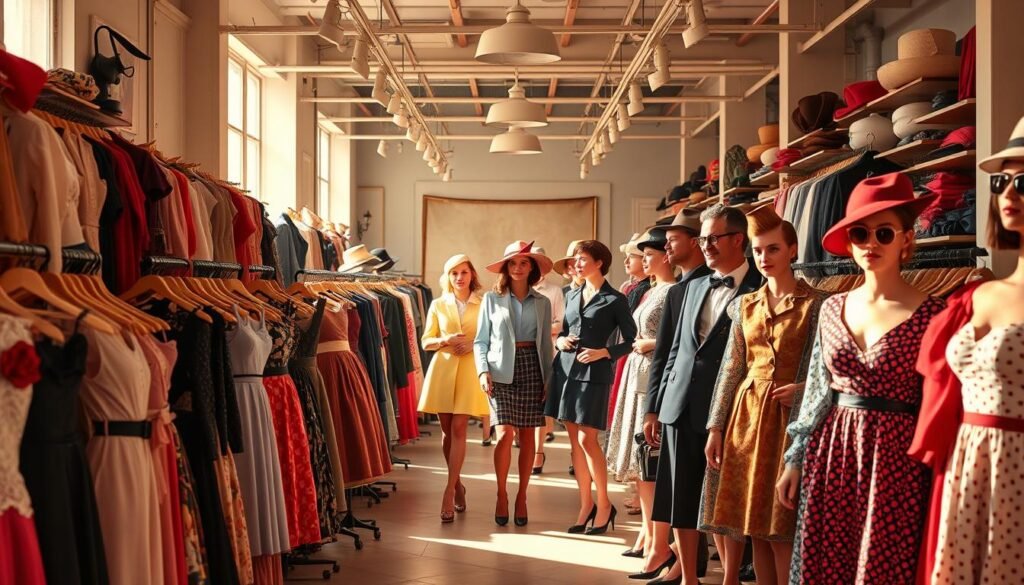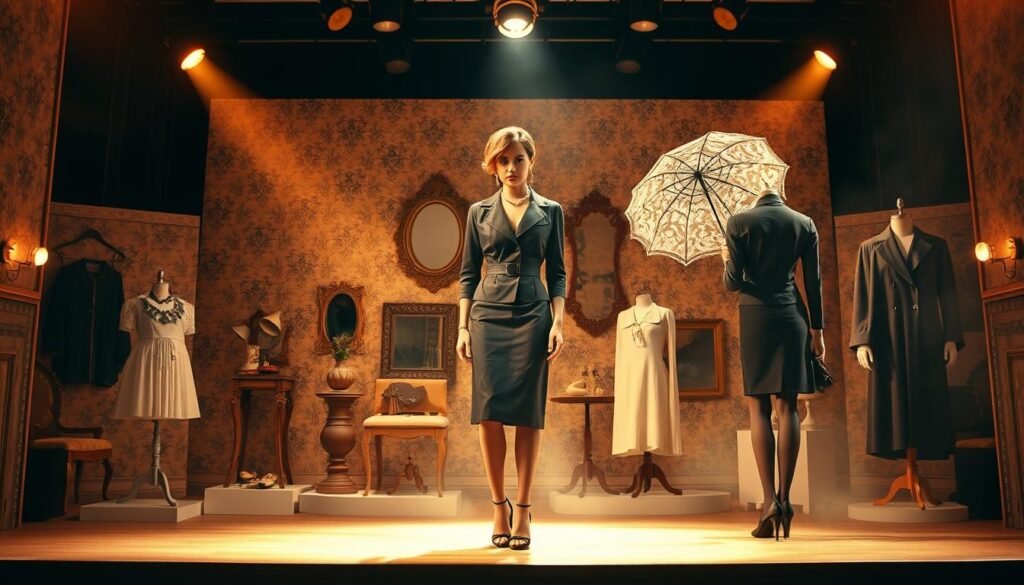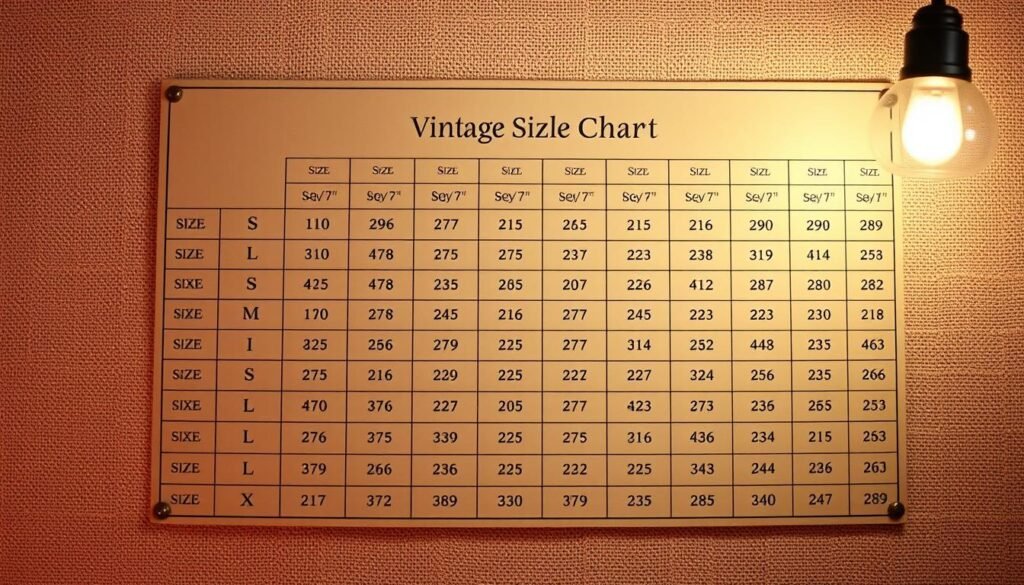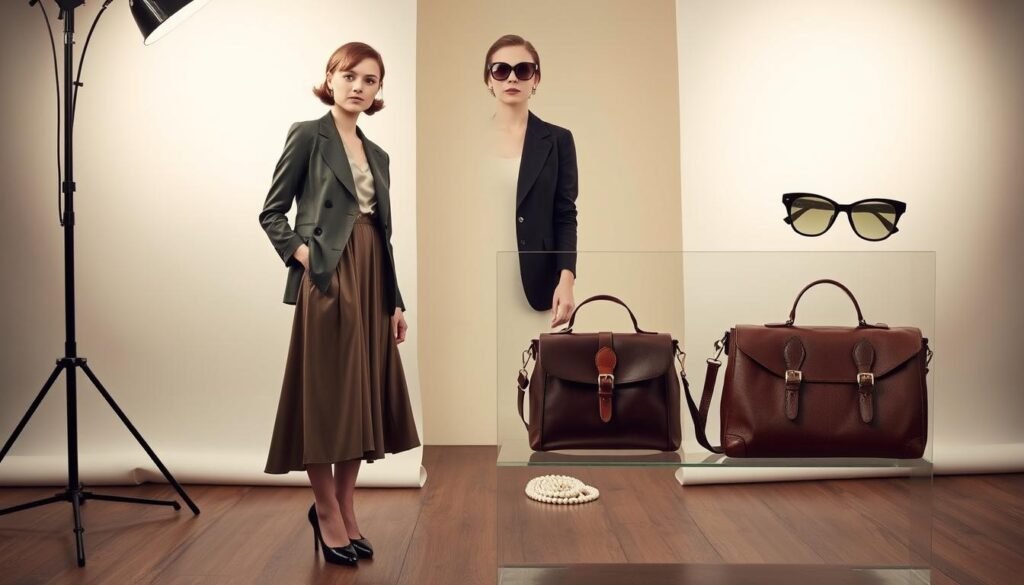“Fashion fades, only timeless fashion remains eternal,” said Coco Chanel. This quote shows why some pieces last forever. Today, people love mixing old and new in their outfits.
Creating authentic vintage clothing looks is not about time travel. It’s about respecting fashion history and staying modern. Highland Redstone says combining old and new makes your style unique.
Claire Pepper believes in choosing quality over trends. Daria Andronescu shows how blending styles keeps your wardrobe fresh and exciting.
This guide will teach you how to style vintage without looking like you’re in a costume. You’ll learn how to shop, care for, and style your clothes. Whether you love 1950s glamour or 1970s bohemian, you’ll find ways to make it your own.
Key Takeaways
- Master the art of blending classic pieces with modern trends for contemporary appeal
- Choose quality, timeless pieces over fast fashion to build a lasting wardrobe
- Learn practical shopping strategies for finding authentic pieces that suit your lifestyle
- Discover styling techniques that honor fashion history while feeling current
- Understand how to maintain and care for precious finds properly
- Create personalized looks that reflect your unique aesthetic without appearing costume-like
Understanding the Fundamentals of Vintage Fashion
Getting into vintage style means knowing the real deal from fake. This knowledge is key to creating a wardrobe that truly feels like it’s from another time. It helps you make better choices when shopping and spot quality pieces.
The world of retro fashion can be tricky for newcomers. Many confuse vintage-inspired clothes with the real thing. Knowing the difference saves money and builds a more genuine collection.
Defining True Vintage vs. Vintage-Inspired Pieces
True vintage clothing is from 20-30 years ago. These items have the original construction and design of their time. They often show signs of aging that make them special.
Vintage-inspired pieces are new items made to look like old clothes. They capture the look of historical fashion but lack the real craftsmanship and materials of true vintage.
| Feature | True Vintage | Vintage-Inspired |
|---|---|---|
| Age | 20+ years old | Recently manufactured |
| Construction | Period-specific techniques | Modern manufacturing |
| Materials | Natural fibers, metal zippers | Synthetic blends, plastic hardware |
| Price Range | Varies widely | Generally lower cost |
Key Characteristics of Authentic Vintage Clothing
Authentic vintage clothes have unique features that modern copies can’t match. Hand-finished seams are a sign of old-school craftsmanship. This is something mass production can’t do today.
Look for natural fiber fabrics like wool, silk, and cotton. These feel different from synthetic materials and often have special textures. Metal zippers and buttons are also signs of real vintage, as plastic became more common later on.
Exploring Iconic Fashion Decades for Inspiration

Learning about major fashion eras helps you create authentic vintage looks. Each decade brought big changes that shape our style today. By exploring these periods, you can pick elements that fit your style and respect fashion history.
Vintage fashion eras are diverse and unique. They offer everything from structured to free-flowing styles. Fashion through the decades shows how these styles evolved and why they’re relevant now.
1920s Flapper Elegance
The roaring twenties introduced dropped waistlines and shorter hemlines. These changes challenged old dress codes. Beaded embellishments, geometric patterns, and straight silhouettes defined this era. These styles focus on comfort and movement, great for today’s active woman.
1950s Feminine Silhouettes
Post-war fashion celebrated femininity with cinched waists and full A-line skirts. This decade perfected the hourglass figure with structured tailoring. The focus on refined details and quality makes fifties-inspired pieces timeless.
1960s Mod Revolution
The swinging sixties introduced geometric patterns, mini skirts, and bold color blocking. This era showed youthful optimism with clean lines and futuristic designs. Mod fashion’s simplicity and graphic elements are great for modern looks.
1970s Bohemian Chic
The seventies loved flowing fabrics, earthy tones, and ethnic prints. This era’s free-spirited vibe is captured in relaxed silhouettes and natural materials. Bohemian elements add effortless elegance to today’s vintage-inspired outfits.
Building Your Vintage Wardrobe Foundation
Smart vintage fashion lovers know the secret to a great wardrobe. It’s about choosing pieces that last long and look good all year. By picking vintage wardrobe essentials, you can make many stylish outfits. The trick is to find items that match well and show off your style.
Must-Have Pieces for Maximum Versatility
Every vintage wardrobe needs key pieces that can be worn in many ways. A good blazer can make any outfit look better. Classic A-line skirts are flattering and go with lots of tops.
Coats or jackets with bold designs can start conversations and keep you warm. Vintage blouses with special details like pearl buttons add a unique touch to simple pants or skirts. These essential items help you mix and match to create trendy outfits.
Spotting Superior Construction and Materials
Finding quality vintage clothing means looking at the details. Choose items made from natural fibers like wool, silk, or cotton. Check the seams for quality and finish.
Good hardware is important too – buttons should feel solid, and zippers should work smoothly. A piece that looks well-worn but is well-made is worth buying. Well-made vintage clothes often last much longer than fast fashion.
Smart Financial Planning for Vintage Shopping
Having a budget helps you buy wisely without spending too much. Vintage clothes are often pricier than fast fashion but cheaper than new designer items. Prices depend on the era, designer, condition, and rarity.
Buying fewer, better-quality items is smarter than getting lots of cheap ones. Start with the basics and add special items as your collection grows.
Perfecting Your Vintage Style Through Strategic Mixing

Strategic mixing is key to vintage styling. It lets you make looks that are both timeless and fresh. The trick is to know how to mix elements for harmony, not chaos.
This method keeps your outfits from looking like costumes. Yet, it keeps the real charm of vintage pieces. Style mixing techniques need practice and patience, but they’re worth it.
The 70-30 Rule for Vintage-Modern Balance
Highland Redstone suggests starting with a main piece and adding contrasting items. The 70-30 rule helps achieve modern vintage balance. It means using mostly vintage or modern pieces in your outfit.
For a 70% vintage look, add 30% modern accessories or shoes. This keeps your outfit from feeling too old while highlighting vintage pieces.
For a modern look, add vintage accessories or a statement piece. This makes your outfit feel planned, not random.
Combining Different Vintage Eras
Mixing decades needs finding common ground between pieces. Look for similar colors, shapes, or textures.
A 1950s skirt and a 1970s blouse work well together if they share earth tones. The goal is to find elements that tie different eras together visually.
Daria Andronescu shows how monochrome outfits can unite different eras. This method makes mixing eras easier while keeping your look sophisticated.
Incorporating Contemporary Accessories
Modern accessories link vintage pieces to today’s fashion. A sleek handbag can update a vintage dress without losing its essence.
Choose accessories that enhance, not clash with, vintage items. Simple jewelry, updated shoes, or modern belts can refresh how vintage pieces feel.
| Vintage Base | Modern Addition | Style Impact |
|---|---|---|
| 1950s Dress | Contemporary Sneakers | Casual, approachable |
| 1970s Blouse | Modern Structured Bag | Professional, polished |
| 1960s Skirt | Current Season Boots | Trendy, updated |
| Vintage Blazer | Modern Minimalist Jewelry | Refined, contemporary |
Successful mixing is all about careful selection. Each piece should contribute to your overall look.
Shopping Strategies for Authentic Vintage Finds
Vintage shopping is all about patience, knowledge, and smart strategies. You’re looking for that special coat from the 1960s or elegant accessories from the 1950s. Knowing where to find these items is key. Follow these vintage shopping tips to create a wardrobe full of real treasures.
Best Places to Find Quality Vintage Pieces
Specialized vintage boutiques are the best for authentic vintage finds. Owners carefully select and check their items. Estate sales offer unique finds at good prices. High-end consignment shops have designer vintage pieces in great condition.
Thrift stores in rich areas can surprise you with great finds. Antique malls and flea markets are full of accessories and small vintage items. Online shops give you more choices but need careful checking.
Thrift Store and Estate Sale Tips
Get there early to find the best items. Serious collectors come early. Bring a measuring tape because vintage sizes are different.
Check items well for stains, tears, or missing parts. These can affect how well you can wear them or how much fixing they need.
Look for quality materials like wool, silk, and cotton. Check labels and tags for clues about the item’s age and authenticity.
Online Vintage Shopping Guidelines
Do your homework on sellers by reading reviews and checking their return policies. Ask for more photos if the listing doesn’t show enough. Retro fashion bought online needs careful attention to measurements and condition.
Professional sellers give accurate measurements, detailed condition reports, and clear photos of any flaws. This shows they are reliable and helps avoid bad purchases.
Sizing and Fit Considerations for Vintage Clothing

The secret to classic looks is knowing how to fit vintage clothing right. Vintage clothes have their own sizing rules, which can be tricky to figure out.
Getting these sizing considerations right can save you money and make your clothes look great on you.
Decoding Historical Sizing Systems
Vintage sizes changed a lot over time and between brands. For example, a 1950s size 12 might be a size 6 or 8 today. Always check the garment’s size by measuring it, not just the label.
Each time period had its own way of sizing clothes. The 1950s were all about precise fits for structured looks. The 1970s, on the other hand, were about looser fits that fit many body types.
Smart Alteration Strategies
Small changes like hemming or adjusting side seams can make a big difference. Find tailors who know how to work with vintage clothes. But, avoid big changes that ruin the original look.
Stick to alterations that improve the vintage clothing fit without losing its historical charm.
Mastering Period-Appropriate Proportions
Vintage clothes were made for different body shapes and undergarments. You might need special foundation pieces to get the right look.
Knowing these proportions helps you pull off classic looks while keeping your clothes comfortable and stylish today.
Creating Modern Vintage Outfits for Different Occasions
Learning to mix occasion dressing with vintage pieces is key. It’s about making classic styles fit today’s needs. This way, you keep the charm of vintage fashion alive.
Whether you’re going to work, a weekend outing, or a special event, vintage clothes can make your outfit pop. They offer a unique twist on regular fashion.
Professional Vintage-Inspired Workwear
Professional vintage style is all about finding the right mix. A 1940s blouse looks great with modern trousers and pumps.
Look for pieces with special touches like pleats or vintage buttons. These add flair to your work clothes without looking too out of place. Structured blazers from the 1950s pair well with today’s skirts or pants.
Casual Weekend Retro Looks
Weekends are the time to get creative with vintage. Try pairing high-waisted jeans from the 1970s with vintage band tees or retro blouses.
Pair these with modern sneakers or boots for a comfy vibe. Denim jackets and vintage cardigans are great for layering. They mix old and new styles perfectly.
Evening and Special Event Styling
Evenings and special events are perfect for showing off bold vintage pieces. A 1920s beaded dress is stunning for nights out. 1950s cocktail dresses add elegance to any formal event.
For outdoor weddings or garden parties, go for a 1970s maxi dress. Occasion dressing is easy when you match these pieces with the right accessories and undergarments. This way, you stay comfortable all night.
Accessorizing Your Vintage Looks

Choosing the right accessories can make your vintage outfits both authentic and modern. The right pieces can turn a simple look into a full retro fashion statement. They add a personal touch and polish, helping you achieve perfect style coordination.
Choosing Period-Appropriate Accessories
Authentic vintage accessories bring history to your look. A classic pearl necklace pairs well with 1950s dresses. Vintage brooches add elegance to 1940s blazers.
Structured handbags and leather gloves complete many vintage outfits. Cat-eye sunglasses bring 1950s glamour. Statement belts can make loose vintage dresses fit better.
Modern Accessories That Complement Vintage Pieces
Modern accessories keep your retro fashion from feeling too old-fashioned. Modern shoes are more comfortable than vintage ones. Sleek handbags offer style and function.
Minimalist jewelry balances with ornate vintage pieces. Modern watches fit well with vintage outfits. When learning to match vintage outfits, mixing eras makes them more wearable.
Hair and Makeup Considerations
Your hair and makeup should enhance your vintage accessories without overpowering them. Soft waves are perfect for 1940s and 1950s looks. Sleek, geometric cuts suit 1960s mod styles.
You don’t need exact period-accurate styling to look great. Loose, natural textures are great for 1970s bohemian looks. The key is to know which styles complement your chosen vintage silhouettes.
| Era | Key Accessories | Hair Style | Makeup Focus |
|---|---|---|---|
| 1940s | Brooches, gloves, structured bags | Victory rolls, soft waves | Red lips, defined brows |
| 1950s | Pearl necklaces, cat-eye sunglasses | Bouffant, pin curls | Winged eyeliner, pink lips |
| 1960s | Statement earrings, chain belts | Beehives, geometric cuts | Bold eyes, pale lips |
| 1970s | Long scarves, wide belts | Natural waves, center parts | Earth tones, glossy lips |
Caring for and Maintaining Vintage Garments
Your vintage pieces are truly special and deserve care. Vintage clothing care means knowing how to handle older fabrics and construction. With the right care, these garments can stay beautiful for years to come.
Proper Storage Techniques
Storing your vintage clothes right is key to keeping them safe. Use padded hangers for items like blazers and dresses. Acid-free tissue paper is great for folding delicate items in drawers.
Garment bags that breathe help keep dust off while letting air in. Store them in a cool, dry place to avoid mold and fabric damage.
Cleaning and Preservation Methods
Garment preservation begins with gentle cleaning. Always check the care labels, but they might be old. If unsure, get help from experts in historical textiles.
Hand-washing is best for many vintage items with pH-neutral detergents. Stay away from harsh chemicals that can harm fabrics or change colors.
Handling Delicate Fabrics
Special fabric maintenance is needed for vintage clothes. Be extra careful with silk, lace, and beaded items. Check for loose buttons or small tears that need fixing.
Fixing small problems early can prevent bigger issues. This way, your vintage clothes stay in great shape.
Avoiding Common Vintage Styling Mistakes
Mastering vintage fashion means avoiding common mistakes. These errors can turn elegant classic looks into something that looks like a costume. Many people fall into these traps without knowing how it affects their style.
Understanding these vintage styling mistakes helps you create outfits that are both sophisticated and current. This way, you honor the past while keeping your look fresh.
Costume vs. Contemporary Vintage Style
The biggest mistake is making outfits that look like Halloween costumes. Claire Pepper says to make vintage feel current, not costume-like. This means picking and choosing vintage pieces wisely.
Choose one or two vintage pieces to be the stars of your outfit. Pair them with modern basics to keep your look grounded. For example, a 1950s circle skirt looks great with a modern tee and shoes.
Overdoing the Vintage Look
Highland Redstone warns against too much vintage. Too many vintage details can be overwhelming. It’s better to focus on one or two standout pieces.
Contemporary adaptation is about restraint. Let each vintage piece stand out on its own. Avoid mixing too many vintage items in one outfit.
Ignoring Modern Fit Standards
Proper fit is key to a great vintage look. Even authentic pieces need adjustments for modern body shapes. Don’t sacrifice comfort or style for historical accuracy.
| Common Mistake | Better Approach | Result |
|---|---|---|
| Head-to-toe vintage | Mix vintage with modern | Contemporary style |
| Poor fit acceptance | Professional alterations | Flattering silhouette |
| Too many vintage details | One statement piece | Elegant balance |
Adapting Vintage Trends for Today’s Lifestyle
The art of vintage adaptation is about keeping timeless elegance alive. It also meets today’s practical needs. Successful lifestyle integration turns old fashion into pieces that fit your daily life. This way, you get authentic style without losing comfort or function.
Making Vintage Practical for Modern Life
Smart layering makes vintage pieces versatile. A 1950s dress works well with today’s shapewear and modern cardigans. Choose items that match today’s undergarments and cleaning methods.
Strategic selection means picking pieces that last. Look for strong fabrics and classic cuts. This, as Claire Pepper says, helps you make better choices.
Updating Vintage Silhouettes
Subtle changes keep vintage charm while improving fit. Shortening hemlines makes dresses modern without losing their essence. Adjusting sleeves or adding modern touches makes them more functional.
These tweaks turn trendy outfits that look fresh, not like costumes. Highland Redstone’s way of making traditional clothes practical is spot on here.
Incorporating Technology and Functionality
Modern accessories blend vintage and modern perfectly. Sleek smartwatches go well with vintage jewelry. Bags with vintage looks but modern function hold today’s essentials.
Using modern fabrics in vintage styles means better care and durability. This modern vintage adaptation honors the past while meeting today’s needs. The outcome is lifestyle integration that feels natural and lasting.
Building Confidence in Your Personal Vintage Aesthetic

Fashion confidence grows when you trust your instincts and choose vintage pieces that speak to you. Fashion expert Daria Andronescu says, fashion should be fun and a way to express individuality. This mindset helps you create a vintage look that’s truly you.
Your journey toward personal style development needs patience and self-reflection. Notice which vintage pieces make you feel most comfortable and confident.
Developing Your Signature Vintage Style
Creating your signature look begins with honest self-assessment. Find out which historical silhouettes flatter your figure and which styling approaches fit your personality. Vintage styling is best when it matches your lifestyle and comfort level.
Claire Pepper suggests developing your personal style by starting with clothes you already own. Then, add vintage elements that enhance your wardrobe.
Experimenting with Different Eras
Don’t stick to just one decade when building fashion confidence. Mix 1940s tailoring with 1970s colors, or combine 1960s mod shapes with 1950s feminine details. These combinations often lead to the most interesting and personal vintage looks.
Each era has unique design elements that might resonate with different parts of your personality. Explore freely without feeling pressured to stick to one time period.
Making Vintage Fashion Your Own
True vintage style confidence comes from using historical inspiration as a starting point, not strict replication. Let your modern sensibilities guide your choices while honoring the craftsmanship of vintage clothing.
Your personal style development should reflect who you are today, not who you think you should be based on historical standards. This authentic approach builds lasting confidence in your vintage aesthetic.
Conclusion
Your journey into vintage fashion is more than just picking clothes. It’s a creative adventure that celebrates your style and fashion history. Highland Redstone says fashion is a powerful way to express yourself. Mixing old and new creates looks that are both meaningful and smart.
You’ve learned a lot from this guide. You know how to spot real vintage pieces and make classic looks work today. Now, you can build a wardrobe that truly shows who you are.
Daria Andronescu believes fashion should be an adventure and a way to show off your unique style. This view perfectly captures the spirit of vintage fashion. Every piece you pick tells a story, and every outfit is a chance to show your personal taste.
Your vintage style will keep growing as you try new things and get more confident in your choices. The timeless style you create today will evolve with you. It shows that great fashion lasts beyond fleeting trends.
Remember, building your vintage style is a continuous journey. Trust your instincts, try new things, and enjoy the process. Creating looks that honor fashion’s history while showing your unique style is rewarding.

